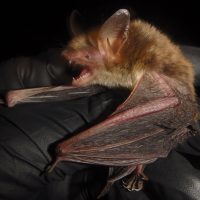
Northern Long-eared Bat (Myotis septentrionalis)
On November 29, 2022, the U.S. Fish and Wildlife Service (USFWS) announced a final rule to reclassify the northern long-eared bat (Myotis septentrionalis) as “endangered” under the Endangered Species Act (ESA). The rule takes effect on January 30, 2023.
This change in status from “threatened” to “endangered” signifies that this species requires additional conservation efforts to address the impacts of its primary threat of white-nose syndrome (WNS). When final, the prior 4(d) rule will be nullified and replaced with protections under the ESA.
The northern long-eared bat faces extinction due to the devastating impact of WNS, a deadly disease that is decimating cave-dwelling bats and “has spread to approximately 80% of the species’ range and almost all of the U.S. range since it was listed as threatened in 2015…and is expected to affect 100% of the northern long-eared bat’s U.S. range by 2025, spreading more quickly than anticipated across the continent.”
The change in the species’ status comes after an in-depth review found that northern long-eared bat populations continue to decline, and the species now meets the definition of an endangered species under the ESA. Data indicate white-nose syndrome has caused estimated declines of 97 to 100% in affected northern long-eared bat populations. Other factors influencing northern long-eared bat viability—though to a far lesser extent than the influence of WNS—include wind energy mortality, effects of climate change, and habitat loss.
In many cases, the USFWS will identify “critical habitat” areas considered particularly important for the survival of an endangered species. Officials decided against doing so for the northern long-eared bat because habitat loss isn’t the primary reason for its decline, spokeswoman for the USFWS Georgia Parham said. She added, calling attention to their winter hibernation spots could make things worse.
Found in 37 states in the eastern and north central United States, the northern long-eared bat is one of many bat species that are critical to healthy, functioning natural areas and contribute at least $3 billion annually to the U.S. agriculture economy through pest control and pollination. Northern long-eared bats live in mature interior forests and forage along wooded hillsides and ridgelines. Recovery efforts will focus on wooded areas where these bats roost in the summer, typically solitary or in small groups, beneath bark or within tree cavities and crevices.

EnviroScience Bat Ecologist Mary Gilmore
Transportation projects covered under various programmatic consultations will not be impacted by the reclassification provided they are completed by January 29, 2023. The USFWS is developing tools to assist project proponents with consultations for endangered bat species and updating programmatic consultations with federal agencies.
EnviroScience can help you navigate your project and streamline the ESA Section 7 Consultation process. Our bat biologists routinely conduct both acoustic and mist-net bat surveys, develop conservation and management plans, and work with clients to create conservation and avoidance measures. ES bat experts are qualified to work with the federally endangered Indiana bat (Myotis sodalis) and the northern long-eared bat, as well as the gray bat (Myotis grisescens)—another federally endangered cave-dwelling bat species.
Visit https://www.enviroscienceinc.com/services/threatened-endangered-species/endangered-bats/ for more information, or give us a call at 800.940.4025 to answer any questions or concerns as to what this reclassification may mean for your projects.
The tricolored bat is another cave-dwelling bat species whose population has been decimated by WNS and is currently proposed to be listed as endangered. The comment period for the proposed rule to list the tricolored bat as endangered closed on November 14, 2022. The USFWS is currently evaluating all information received during the comment period and will announce a final decision within 12 months. EnviroScience will continue to post updates on the status of these bats and updates to regulatory guidelines.
Few environmental firms in the country retain EnviroScience’s degree of scientific know-how, talent, and capability under one roof. The diverse backgrounds of our biologists, environmental engineers, scientists, and divers enable us to provide comprehensive in-house services and an integrated approach to solving environmental challenges—saving clients time, reducing costs, and ensuring high-quality results.
Our client guarantee is to provide “Excellence in Any Environment” meaning no matter what we do, we will deliver on our Core Values of respect, client advocacy, quality work, accountability, teamwork, and safety. EnviroScience was created with the concept that we could solve complex problems by empowering great people. This concept still holds true today, as our scientists explore the latest in environmental legislation and regulations and incorporate the most up-to-date technology to gather and report data.
EnviroScience expertise includes but is not limited to: aquatic survey (including macroinvertebrate surveys and biological assessments); ecological restoration; ecological services (including impact assessments, invasive species control, and water quality monitoring); emergency response; engineering and compliance services; endangered mussel surveys; laboratory and analysis; stormwater management; threatened and endangered species; and wetlands and streams (including delineation and mitigation). Further, EnviroScience is one of the few biological firms in the country that is a general member of the Association of Diving Contractors International (ADCI) and offers full-service commercial diving services.



